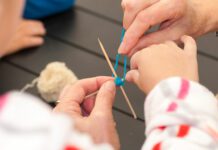It was Friday afternoon. My wife and I were in the mall, and I was doing the nice husband thing and following her from one store to the next.
As we were approaching yet another shop, I saw a bright light and I heard angels singing…
Well, not really…but it was close enough. I saw an Apple store for the first time in my life.
IMMEDIATELY I THRUST MY CREDIT CARD INTO MY WIFE’S HANDS, ASSURING HER SHE WAS ACTUALLY BETTER OFF WITHOUT ME AND MADE A BEELINE TO THE DOOR.
Inside the store, I was instantly captivated by all the computers, tablets, phones and media players; all of them were in the open, begging me to hold them, push the buttons, swipe my finger across the screen, listen to music, watch videos and browse the web.
Everywhere I looked, people were interacting with devices. There were no passive onlookers. Everyone was engaged and everyone was having a very personal experience.
The iMac jumped out of the box, the iPhone came off the shelf, the iPod sneaked from underneath the glass counter and into my hands—all giving me a chance to explore them and really know them.
That is when it occurred to me,
THIS IS EXACTLY WHAT LIFE WITH GOD SHOULD BE LIKE—INTERACTIVE, ENGAGING AND PERSONAL.
My experience at that Apple store caused me to think about the faith we hold dear and the way we pass this faith to the new generation. I started asking myself,
“Is the Jesus I talk about safely boxed and neatly placed on the shelf of history, or is He out of the box—close and accessible to the children I teach?”
As I reflected on these questions, I realized that over my years in children’s ministry, my classroom experiences more often resembled that of a museum.
In a museum, everything is pointing to the past. Everything is protected by glass or red rope. Every 10 feet you see another sign urging you not to touch anything.
I wonder if that is the impression of God our children get sometimes—that He is someone who belongs to the past, someone you can only learn about, someone far removed from the lives we live?
Are we unknowingly keeping our children from experiencing Jesus in their daily lives by presenting Him as a museum artifact—significant yet removed from our present reality?
That is exactly what the well-meaning disciples did when they told the children to stay away from Jesus.
They tried to rope Jesus off and make Him inaccessible. This made Jesus furious.
He commanded them, “Let the children come to Me and do not forbid them.”
Next, Jesus opened the “apple store” by inviting kids to climb all over Him, by placing His hands on them and speaking words of life over them.
Jesus didn’t feel comfortable being a museum exhibit then and I don’t think He wants to settle for that role today.
Since that memorable visit to the Apple store, I have become more intentional about “letting children come to Jesus,” making sure they regularly have a chance to interact with Him and invite His power into their lives.
I am afraid that often children’s ministries are guilty of being a museum.
This happens when we merely teach Bible content.
While stories about Jesus are absolutely necessary—they reveal to us who He is and give us reason to believe—if we only pass stories, we risk giving our children just half of Jesus, the Jesus boxed as a historical figure.
IN DOING SO, WE PRESERVE THE ANCIENT STORIES AND PASS ON THE FAITH OF OUR FATHERS BUT WE ARE NEGLECTING TO INVITE OUR CHILDREN INTO A PERSONAL AND RELEVANT EXPERIENCE WITH JESUS.
In order to make sure that we give children 100 percent of Jesus and not only half of Him, in our church we’ve made “Lab Experiences” an essential part of what we do on Sundays.
Just like other children’s ministries, we open the Bible and we invite children to explore the sacred texts but then we go a step further—we encourage children to open their hearts and invite God into a specific area of their lives.
This is the time when they interact with God and experience Him for themselves.
The following seven components make up each of our lab experiences:
1. Start with where the children are.
A good shepherd knows his sheep (John 10:14).
As a shepherd of your young flock, you can’t expect to have a profound impact on the lives of children if you don’t take time to discover them and find out where they are at.
What are they most excited about? What are they afraid of? What are their dreams? What are their doubts and questions? How do they see God? How do they see themselves?
Be curious about children. Ask a lot of questions and draw them out. This will engage them, make the experience personal, and set the stage for everything that follows.
Jesus always meets us at the point of our honesty and this is exactly where we want to move our children—being fully open about their lives.
2. Create a safe environment.
If we want children to be open and honest about their innermost thoughts, doubts, questions and feelings than we must ensure that we have created a warm and welcoming atmosphere.
Before a child opens up they need to feel safe. Each child needs to know that it’s OK to be me; it’s safe to be real; there’s no need to pretend here.
Emotional safety starts with your attitude—accepting children, celebrating them, your face lighting up when they enter the classroom, giving them your full attention, seeing the best in them, dreaming God-sized dreams for their lives, and honestly talking about your own life, especially your own messes and mistakes.
3. Welcome children into a conversation
If you want children to experience Jesus, you must make sure that you invite their participation.
Don’t look at them as mere listeners or observers. It’s not so much about what you know and want to tell them, but it’s about giving them a chance to talk.
View this part as the confession time where they have a chance to admit where they are at in relationship to…(fear, greed, salvation, Lordship of Christ, forgiveness, and so on).
Children may not be accustomed to exploring their inner being and openly talking about their thoughts and feelings, so it’s your job to engage them and make it easy to have a heart-to-heart conversation.
4. Share personal stories.
Your life experience (whether negative or positive) is one of the best teaching tools you have.
Use it wisely.
Kids connect to stories. Other people’s experiences provide them with hope and give them tools and vocabulary to better understand their own lives.
5. Always point to Scripture.
Creative introductions and moving personal examples are great, but the experience will be incomplete if we don’t connect children to God’s Word which alone has the power to transform their lives.
For greater impact and clarity I suggest choosing shorter passages (one to two verses) that directly speak to the topic.
6. Have a call to action.
Show children how the truth applies to their lives and then give them a chance to put it to the test. This is the part where kids invite God’s presence and truth into their lives. As for the teachers, they get a chance to take a front row seat and watch what God will do in response.
7. Send something home.
Whatever you decide to send home with a child should accomplish two goals:
1) serve as a reminder of the commitment they made during the class and
2) invite their parents into the spiritual journey of their child by offering them accountability and encouragement.
THE LAST THING THAT NEEDS TO BE SAID IS PRAY, PRAY, PRAY!
Have great expectations and leave time for God to interact with the children and bring about the change He desires. You’re only setting the stage. He is the Hero who shows up and saves the day.
Speaking in the “apple store” metaphor, your job is to take Jesus out of the box and put Him on display where He’s fully accessible. You unbox Jesus by creating an emotionally safe environment, inviting children into honest conversations, connecting them with God’s Word, and giving them a practical way to respond to God’s invitation. Then you step aside and watch them interacting with Jesus, letting Him do what only He can—transforming lives.
You can find two recent examples of “lab experiments” HERE and HERE.
One of these examples deals with helping children overcome their fears and another leads children into a deeper surrender to Jesus, giving Him first place in their lives. They will give you a clear picture of what the “apple store” experience looks like in the context of children’s ministry in our church.
So how about you—are you letting children come to Jesus or only letting them learn about Him? Are you giving them half of Jesus or 100 percent? I invite you to examine the last four lessons you taught and see what you think.
This article originally appeared here.












